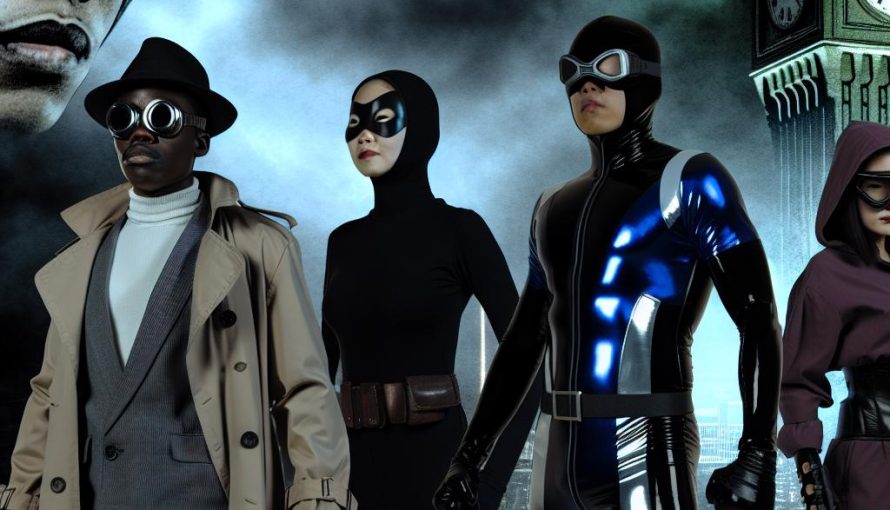Watchmen

Origins and Publication
“Watchmen,” released by DC Comics between 1986 and 1987, emerged during a transformative era in the comic book industry. Conceived by the innovative writer Alan Moore, talented artist Dave Gibbons, and skilled colorist John Higgins, the graphic novel stands out as a benchmark in the realm of comic book storytelling. Unlike conventional superhero narratives, “Watchmen” is celebrated for its multidimensional characters and intricate plot structure. This work contrasts sharply with traditional superhero tales by offering a deconstructive approach to the genre. Initially published as a 12-issue limited series, the entire collection was later compiled into a single volume, making it accessible to a wider audience.
The time of its publication was crucial; the 1980s were characterized by significant political tension, with the Cold War deeply influencing global affairs. Against this backdrop, the novel’s narrative is enriched by its exploration of societal and political issues. This context is crucial to understanding the multilayered storyline that Moore, Gibbons, and Higgins crafted. The comic industry’s atmosphere at the time also contributed to the novel’s reception, as readers were becoming increasingly open to more sophisticated and thought-provoking content.
Plot and Themes
Set in an alternate version of the 1980s, “Watchmen” presents a reality that, while familiar, diverges significantly from actual historical events by including the presence of costumed heroes. The central plot revolves around the mysterious murder of the Comedian, an event that sets off an investigation led by the morally ambiguous vigilante, Rorschach. This investigation gradually uncovers deeper conspiracies and prompts readers to question the very notion of heroism.
One of the most notable themes within “Watchmen” is the psychological intricacy of its characters, each of whom is navigating their internal struggles and moral quandaries. This internal complexity adds depth to their exterior superhero facades, making them more relatable and human. The novel also extensively explores the societal implications of vigilantism, raising questions about justice and the blurred line between right and wrong. The moral ambiguity characteristic of Moore’s storytelling encourages readers to consider various perspectives and the multifaceted nature of truth.
Characters
The characters in “Watchmen” are pivotal in advancing the central themes and plot, each contributing a unique perspective to the story.
Rorschach: Serving as both a character and a narrative tool, Rorschach is known for his unyielding moral code and his signature inkblot mask. His personal journal entries serve as a narration that provides insights into the broader narrative and injects personal commentary on unfolding events, allowing readers an intimate look at his worldview.
Dr. Manhattan: As a superhuman entity with nearly omnipotent powers, Dr. Manhattan symbolizes the duality of superhuman abilities. His powers lead him to a state of existential detachment, raising philosophical questions about the relevance of human life and emotions. This detachment is a theme readers can explore in terms of real-world power dynamics and the responsibilities that come with great power.
Ozymandias: Renowned as the most intelligent man alive, Ozymandias is a complex character whose actions challenge ethical boundaries. His pursuit of a utopian future, even at great moral and human costs, forces readers to grapple with the classic ethical dilemma of whether the ends justify the means.
Nite Owl and Silk Spectre: These characters imbue the story with a sense of humanity and relatability, representing the more personal and emotional challenges that come with leading dual lives. Their struggles contrast with the larger-than-life dilemmas faced by more god-like characters and ground the narrative, making it accessible on a personal level.
Influence and Legacy
“Watchmen” significantly influenced both the graphic novel genre and the broader storytelling landscape. Its narrative complexity and thematic depth prompted a shift in how superhero stories could be told, encouraging more mature and critically engaging content that appealed to a diverse audience. This work dared to challenge the prevailing norms of its genre, and its impact can be seen in various subsequent works that sought to replicate or build upon its innovation.
In 2009, Zack Snyder directed a feature film adaptation of “Watchmen,” introducing the story to an even broader audience. This cinematic portrayal captured the essence of the novel while bringing new visual dimensions to its storytelling. Later, the novel’s themes and narrative were further expanded upon by an HBO television series in 2019. This series continued the story, thereby extending its influence and relevance in contemporary discussions on morality, power, and justice within the superhero genre and beyond.
Further Exploration
For those eager to delve deeper into the themes presented in “Watchmen,” exploring additional works by Alan Moore can offer valuable insights into his narrative style and recurring thematic concerns. Novels like “V for Vendetta” and “From Hell” share Moore’s signature complexity and thematic depth, providing a broader understanding of his creative vision.
Furthermore, gaining a deeper appreciation for the cultural and historical context of “Watchmen” can enhance one’s understanding of its narrative layers and the motivations behind its characters. This can be achieved through various resources, including academic analyses, essays in comic book literature, and online publications dedicated to exploring these works. Such explorations provide richer insights into the narrative strategies and thematic undertones that make “Watchmen” a pivotal piece of literature.